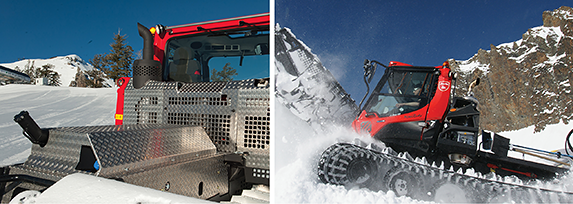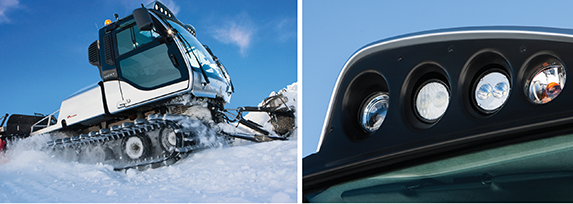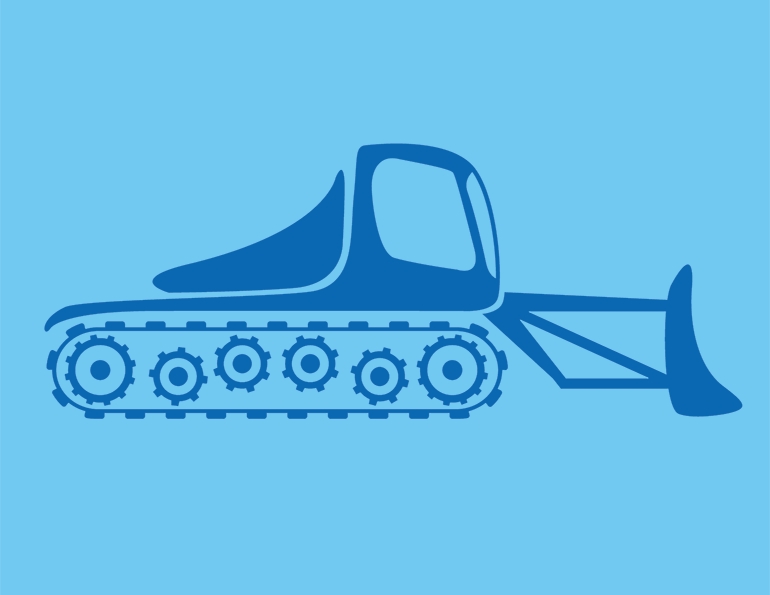There are some significant differences between the two companies’ approach to Tier 4. PRINOTH used the transition as an opportunity to redesign its vehicles and standardize a lot of the technology on its vehicles, blending technology from both the PRINOTH and Bombardier lines. PistenBully took the opposite approach: it sought to incorporate Tier 4 with as little change as possible, to make the transition to Tier 4 nearly seamless for customers. Its new Tier 4 machines will be very familiar to operators and mechanics, drivetrains aside.
In either case, Tier 4 cats achieve improvements in fuel economy and power. Tier 4 adds about 10 percent to the overall cost, though, and will dictate changes in maintenance. Such is the price of progress.
None of the drivetrain changes have detracted from the raison d’etre of these vehicles, however. Technology has made them more efficient than ever. Here’s a look at each company.
PISTENBULLY
Under the umbrella of its “Blue IQ” mission, PistenBully is pursuing technology that encompasses financial, social, and environmental goals as well as performance. And the key expressions of this mission are the diesel electric PB 600 E+, the incorporation of Tier 4 engine and exhaust systems throughout the PB 400 series, including the Park and Winch versions, and the SNOWsat snow depth management system.
PB 600 E+
The 600 E+, introduced a year ago, remains the flagship and technology leader. From the cab forward, it’s a 600. But the hybrid diesel-electric drivetrain is completely new, even revolutionary.
PistenBully, which introduced hydrostatic drives back in the 1970s, believes that electric systems like those of the 600 E+ are the way of the future. The reason is simple: electric systems are more efficient.
The key electrics are the five identical motors/generators. All of the five can serve either purpose, and how they are used is controlled by computer, which regulates the amount of power/throttle. This makes the 600 E+ “a generator on tracks,” as Sierra branch operations manager Jeb Ellermeyer puts it.
Each track is powered by its own electric motor, as is the tiller. The two generators are driven by the diesel engine and supply the current for the electric motors.
As a result, “The 600 E+ has the equivalent tractive effort and pushing power of the 490 hp PB Polar—except that the output is immediate and more consistent,” says marketing manager John Glockhamer, with none of the lag that hydraulic systems have. It’s a noticeable difference, and one that operators can feel.
 Left: PistenBully PB 400 Tier 4‘s compact new engine/exhaust configuration leaves the rear deck little changed. Right: PB’s Tier 4 400 Park Pro, above, as well as the PB 400 and 400 Winch, offer increased horsepower and torque, and fuel consumption roughly equivalent to earlier Tier 3 iterations.
Left: PistenBully PB 400 Tier 4‘s compact new engine/exhaust configuration leaves the rear deck little changed. Right: PB’s Tier 4 400 Park Pro, above, as well as the PB 400 and 400 Winch, offer increased horsepower and torque, and fuel consumption roughly equivalent to earlier Tier 3 iterations.
Unlike an on-road hybrid, the 600 E+ doesn’t use batteries to store energy. Instead, the 600 E+ uses regenerative energy actively: going downhill, the tracks turn the motors, which serve as generators to power the tiller motor. Going downhill, the diesel engine never runs higher than 1000 rpm, even at top speed.
But like an on-road hybrid, the 600 E+ delivers about 20 percent greater fuel economy, and a similar reduction in emissions. Electric motors are 90 to 95 percent efficient; with hydrostatic systems, there’s friction and heat, making them about 65 to 70 percent efficient.
Another reason for the improved fuel efficiency: the diesel engine is not running at peak load. Instead, it runs nearly steady around 1,000 rpm, powering the electric motors that do the actual work. The overall system has fewer moving parts, and the five electric motors can share parts—which should result in lower maintenance and operating costs.
The 600 E+ hasn’t eliminated all hydraulics, though. The blade is still hydraulically driven, along with the tiller lift frame. But these hydraulics run at a much lower pressure than hydrostatics, which reduces wear on the hoses and the chances for a blowout that can lead to a spill and the cleanup that entails.
SNOWsat
PistenBully’s SNOWsat system for fleet management and snow depth measuring can cut grooming and snowmaking costs by up to 15 percent, thanks to reduced snowmaking expenses, improved fuel economy, and reduced operating time. The SNOWsat data provides information on fuel efficiency and productivity, but the big plus is snow depth measurement. Resorts using SNOWsat often find that even veteran operators can have difficulty accurately estimating snow depths. With SNOWsat, natural snow caches that exist on a typical run can be identified and harvested to supply snow coverage to low-snow areas.
SNOWsat enables more efficient snowmaking operations by measuring how much snow is actually being produced, and where it is distributed. This allows snowmaking teams to make more informed decisions about how many guns to run and for how long—leading to cost savings. The system is accurate to about 3 cm, a little more than an inch—which means that snowmakers don’t produce more snow than needed, and that cat operators can distribute it more evenly. The snow depth information is available onscreen in the cab in real time, so operators can make adjustments immediately.
The SNOWsat system’s antennae, receivers, and computers are not cheap, and the process requires a thorough digital map of the hill that includes terrain variations, snowmaking hydrants, and other landmarks. But that also makes these items easier to find for any purpose, as in the case of a water main failure, and PistenBully believes the longer-term payback in efficiency more than makes the up-front effort worthwhile.
Tier 4 PB 400s
All the PB 400 models are now Tier 4—the last of the Tier 3 drivetrains are gone. The PistenBully 400 complies with the stringent Tier 4 final emission standards thanks to an exhaust gas after treatment system supplied by Cummins, comprised of the SCR catalytic converter, combined with diesel emission fluid (urea, also referred to as DEF), and exhaust gas recirculation to reduce NOx emissions, while a diesel oxidation catalyst reduces emissions of carbon monoxide and hydrocarbons as well as particulate emissions.
Perhaps because Cummins has been a leader on-road in trucks, the overall emissions package is compact enough that PB was able to integrate the new systems without a total redesign of the cat. The after treatment systems are positioned compactly behind the cab (see photo, above). The DEF storage tank is positioned at the rear behind the hydraulic tank. The end result is a rear dog house and platform deck that have only small increases in overall dimensions. At the same time, the new cats pack 400 hp and 1,200 foot-pounds of torque, up from 370 hp and 1,120 foot-pounds previously.
And that pretty much captures the Blue IQ philosophy in a nutshell: efficiency, sustainability, and performance all in one neat package.
PRINOTH
A year ago, PRINOTH debuted its most changed lineup in several years, mostly due to the adoption of Tier 4 engines. Aside from the new Tier 4 engines and related hardware changes, PRINOTH modernized drivetrains and cabs throughout, and standardized many of the components. All models share the same lighting systems and options, including LED lights. All three models employ the same dashboards, electronics, and diagnostics. That vastly simplifies life for the mechanics; diagnostics can take minutes, not hours.
What was most important to customers—ergonomics, visibility, serviceability, comfortable suspension—has been retained and enhanced, PRINOTH says.
So has performance. Tier 4 required engine manufacturers to reduce NOx and particulates by 90 percent from Tier 3 levels. In accomplishing that, PRINOTH’s suppliers—Caterpillar and Mercedes—also optimized fuel consumption and increased power, and thus productivity.
New HUSKY
The New HUSKY has been designed to be a good pushing cat. Its Mercedes engine delivers up to 228 hp and 664 foot-pounds of torque, a 27 percent increase over the prior HUSKY. It travels at speeds up to 15 mph. It’s available in 8-, 9-, and 10-foot configurations, with tiller width up to 16 feet.
With its small footprint, right-sized power and torque, cab comfort, precise controls, and maneuverability, the HUSKY is well suited for building Terrain Based Learning features, and for building smaller features in the terrain park as well. “The HUSKY has already been used for these purposes at Killington this year,” says a spokesman. To highlight this, the HUSKY has become the grooming partner for Snow Operating’s Terrain Based Learning Program.
Inside, the new cab shows special attention to comfort. There are large windows all around, sound insulation, and a passenger seat. The driver gets a state of the art display, with up to six operator settings for the intuitive and user-friendly controls. The HUSKY can also come with either sticks or a steering wheel, the first time it has offered that option.
 Left: PRINOTH’s HUSKY is now the official grooming partner for Snow Operating’s Terrain Based Learning Program. Along with a power boost, it now comes with choice of either sticks or a steering wheel, the first time the HUSKY has offered that option. Right: All PRINOTHs now offer the option of LED lighting systems.
Left: PRINOTH’s HUSKY is now the official grooming partner for Snow Operating’s Terrain Based Learning Program. Along with a power boost, it now comes with choice of either sticks or a steering wheel, the first time the HUSKY has offered that option. Right: All PRINOTHs now offer the option of LED lighting systems.
New BISON, BISON X, Winch
The New BISON gets a fuel-efficient Caterpillar engine, with 400 hp (up from 350) and 1273 foot-pounds of torque, up 11 percent. It can go three shifts on one tank of fuel, and travel up to 13 mph. Max tiller width is 20.3 feet.
The redesigned cab offers the same benefits as the HUSKY, with a few extras: there’s a sliding roof hatch for increased airflow in the cab, full LED lighting option, and the choice of either left or center seat configuration.
The park-building BISON X has a sliding/swivel seat, for better visibility to the rear; an inclinometer for both the vehicle and blade; tiller flat lock, and a long rear lift frame. It has a new dual blade with back blading teeth, additional eyelets on the blade for greater flexibility when carrying features, and side cutters for greater ease in feature building and finishing.
Also, it has a tape measure feature, making it unnecessary for the driver to exit the cab and measure distances. There are no limits on the length of this tape measure. In addition, it can be set to measure a set distance from a starting point, or to start at zero and count up.
The New BISON Winch comes with a five-ton Automatic winch, the same as on the LEITWOLF: there’s 3,800 feet of cable, and it can operate in auto or eco mode (the latter limits the pulling force, to avoid wear and tear), or in manual mode. The winch has a hydraulic roll out system: you can put it in winch mode, and it easily pulls out at the pick point. It’s completely level hydraulic; no electronics.
The updated Posiflex tiller comes in both standard and premium versions. To reduce maintenance, the finish mat comes in sections, so crews can replace parts rather than the entire mat. The tiller has fixed or float settings and a rotor speed sensor. The premium tiller adds heavy-duty teeth, a finish comb molded into the mat, molded snow guards and beefed-up fenders that shed snow better and are easier to service.
Aspen has been using three Tier 4 BISONs at Buttermilk, home of the X Games. Aside from the machines’ increased pushing power, crews appreciate the layout of lights and controls, all of which are accessible with the right hand, the comfort of the seats, and—most of all—a heating system that maintains a constant temperature throughout a shift.
New LEITWOLF
The LEITWOLF is not only new; it’s mostly new to North America. It was available for demo last winter; the first one purchased was delivered to Sun Valley in December 2015. While the LEITWOLF doesn’t exactly replace The Beast, which has been phased out, the LEITWOLF will be PRINOTH’s biggest machine. It has 523 hp, 1,800 foot-pounds of torque, working width of 14.7 feet, and maximum tiller width of 21.4 feet. The tiller, unique to the LEITWOLF, is on a stinger, which provides for parallel movement to cleanly overlapping passes on uneven, sidehill terrain. It can reach a top speed of 14 mph.
To spread out the weight added by the Tier 4 engine and exhaust treatment systems, PRINOTH gave the LEITWOLFwider tracks. It also has a wider cab. Aside from the comfort and electronics and other interior updates common to all the new PRINOTHs, the LEITWOLF has an electric joystick. Operators can choose from three different settings for blade control, to provide the feel an operator prefers. The LEITWOLF winch has the same three modes as the Bison.
The LEITWOLF also has an adjustable hydraulic suspension. The operator can adapt the suspension to his needs—raise the suspension for greater maneuverability, or lower it for increased climbing capacity. Or, operators can customize the suspension as the crew at Mammoth has: down in front, and up in back. Operators can even change the suspension while on the move.
SNOWHOW AND CLEAN MOTION
PRINOTH’s Clean Motion program aims to improve efficiency and sustainability through optimization of both engines and snow management. Tier 4 engine and exhaust treatment systems are cleaner burning and greatly reduce NOx. Part of PRINOTH’s SnowHow program, its snow depth management system collects data from cat operations and tiller settings, and highlights the most effective ways to operate a fleet. By optimizing both fuel efficiency and snow management, Clean Motion can save up to 20 percent on operating costs, according to the company.






